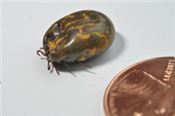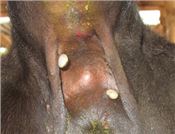Managing Ticks In Pastures
DR. LEE TOWNSEND
LEXINGTON, KY.
American dog ticks (Figure 1) and lone star ticks spend most of their lives on the ground digesting a blood meal, molting to the next developmental stage, or waiting for a host. Cattle and horses pick up hungry ticks as these animals graze and rest in the shade along the margins of woods or in overgrown areas. Reducing tick numbers requires an integrated approach that includes habitat management and animal protection.
Management
Ticks require high humidity and protection from direct sunlight. Mow and remove brush and tall vegetation when practical, or use temporary fencing to keep animals out of tick-infested areas that cannot be cleared. Cleanup also forces other important hosts, such as small mammals, to move. In addition, cleared areas may discourage passage of wildlife that can reintroduce ticks.
Broadcast insecticide sprays over pastures are not justified, but spraying swaths along wooded areas and fence rows after mowing may be useful. For example, some carbarly (Sevin) products are labeled for tick control in pastures. Check the label for harvest and grazing restrictions.
Several insecticides are labeled for tick control on animals; however, it is difficult to treat all sites where ticks may attach (Figure 2). Insecticide-impregnated tags can keep cattle ears free of ticks but do not protect other areas. Thorough coverage of whole animal insecticide sprays can keep newly acquired ticks from attaching but probably have minimal effect on those that are already attached. ∆
DR. LEE TOWNSEND: Extension Entomologist, University of Kentucky

Figure 1. Engorged American dog tick.
Photo: Lee Townsend

Figure 2. Engorged ticks attached under tail.
Photo: P. Scharko